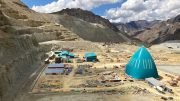Each year in Toronto, at the Prospectors & Developers Association of Canada mining convention, chief executive Mark Bristow holds court at an early morning breakfast meeting for some of the industry’s top bankers, analysts and journalists, where he recounts the latest achievements at his firm Randgold Resources (LSE: RSS; NASDAQ: GOLD).
More often than not, those who rise before dawn and brave the cold to get there on time are as interested in Bristow’s candid thoughts on the state of the gold industry as they are in the recurring themes of the company’s strong performance.
(Randgold has delivered record gold production from its African mines for five years in a row; paid a dividend for eight consecutive years; is debt-free; has ample cash (over US$100 million in the bank at last count); and boasts a 10-year business plan that ensures the company can do business profitably over the next decade at US$1,000 per oz. gold.)
Serial attendees are by now familiar with Bristow’s emphasis on the importance of “not squandering national assets” — particularly in emerging markets — (“you should make a profit, otherwise you don’t pay tax” and “the way to really lose your social licence is … not be able to pay tax, then all hell breaks loose”); the necessity of sharpening local skill sets and ensuring managers are host-country nationals (“when a foreign investor starts a mining operation and drags in all the top senior managers — more than 50% of the payroll sits in the top 15% of your employees on a mine — that just goes straight out of the country”); and the paramount necessity of having a social licence to operate (“I always marvel at the fact that the mining industry spends billions of dollars in building mines and neglects investing in the communities, and then wonders why everyone gets pissed off and burns the place down.”)
In terms of exploration and organic growth, Bristow says West and Central Africa will remain the company’s focus, and that Côte d’Ivoire, the location of its 4 million oz. Tongon deposit, is “the destination of choice.” With the new mining code there, he contends, “it’s really the top address in Africa.
“It’s got very good infrastructure; it’s got a government that looks ahead in planning; it’s got low-cost power, quality people and the biggest surface area underlain by the Birimian sequence of rocks in West Africa,” he explains, “and it’s never been explored because under previous regimes, it’s always been focused on agri-business.”
The challenge in Cote d’Ivoire, however, is that there’s no data. So Randgold has had to generate its own. The company recently compiled, in-house, a new geological map of the whole country, and currently has 12 exploration permits and more than eight outstanding. “We’re committed to controlling the main addresses in this country,” he says, “and right now we have less competition than normal in this stressed market.”
Bristow believes that the best way to replace the assets Randgold is now harvesting is through exploration, but adds that he is “mindful that given the complete crisis that our industry faces, there have got to be opportunities to pursue value-creating M&A.”
He is quick to emphasize, however, that the M&A potential he would consider is “not the sort of M&A that has been recently presented, where everyone is now running around selling Barrick’s and AngloGold’s assets they don’t need, and trying to get full value for them, to be able to give Barrick and AngloGold cash, and leave me with the problem.
“That’s not our business,” he says. “We don’t want to pay full value for assets that are not core to other businesses. We would like to find ways where we can deliver a 20% return to our stakeholders at a US$1,000 gold price.
“These big companies have now woken up to sell their non-core assets and we’ve had the first wave of books from the peddlers of those assets,” he adds. “Not one presentation have I seen yet — and we’ve already had a whole lot — says: ‘Look, Mark, if you buy this asset from this big company, it can actually pay for itself. Let me show you how it pays for itself.’ It’s noxious stuff. The only way it pays for itself, is if it sucks on the cash flow we have already embedded in our business.”
Bristow argues that the industry must “exercise discipline” and stop “producing gold at a loss,” which drives the price down. “As an industry we are always investing in the hope that the gold price is going to go up, rather than in the discipline of making money, so basically we mine away millions of ounces of national assets for no value.
“People always say to me: ‘There’s no connection in the gold market between supply and demand, and that’s bollocks,” he adds. “There’s an absolute connection in the gold market between supply and demand — we saw it in 1999 when the industry borrowed as much gold as they produced and sold it into the market to double up supply, and see what it did to the gold industry? For five years they drove the cost down. When they stopped hedging, what happened?”
In backing up his claims about “how screwed up our industry is,” he points to slides showing that the consolidated gold mining industry has only had positive cash flow for four out of the last 30 years (2008, 2009, 2010 and 2011). “Do you know that the accumulated earnings for the senior and mid-cap gold companies consolidated, is zero?” he says. “Zero! It’s written off all the accumulated earnings … so what’s happening now is the industry is trying to sell the assets to people who don’t want to buy them, to settle their balance sheet and start over again.
“We have a situation where everybody is hoping the next guy is going to go bust — or that somebody is going to buy their assets and give them money to fix their balance sheets, so that their shareholders can become owners of their equity again,” he says.
“That’s the story. And so, despite the fact that Randgold hasn’t impaired anything, that we still manage our business in a holistic sense, and are able to show we are right up there with the best performers as far as our stock performance goes, it gets more and more difficult, as our competitors write down their business, and start afresh — effectively resetting their business. It’s our intention to continue to focus on delivering real value per share, because that’s the only way you get people to continue to buy your stock.
“I’ve watched with interest the industry try and shove paper into the market,” he continues. “You had that little window in January and you had another one in just the last couple of days, and from all accounts, it’s been like trying to push putty into a parking meter.”
As for cost-cutting efforts, he says, one needs to ask oneself why cost-cutting is needed in the first place. Cost-cutting doesn’t save the industry, he argues, it’s just a relief mechanism, because the driver of cost is grade. It’s the value and quality of the asset, he explains, the revenue inside the rock. And the problem is that the gold grade today is half what it was in 2002, and so companies have had to expand capacity to deliver the same amount of gold. The only way to change the unit cost per ounce in the industry, he maintains, is
to “pray for a higher gold price, or exercise discipline and improve the grade of the reserve … it’s time we took out unprofitable production.”
He argues that while “everyone bitches about mining company management,” the “worst in our industry in capital allocation is fund managers, generally.
“I see fund managers now investing in royalty companies, so they’re basically supporting an investment philosophy that destroys equity, because we’re wanting to see these companies suffocate,” he argues. “Every time a company is about to suffocate, there comes the royalty company with a Batman suit on, and administers some oxygen. And that’s not good for the industry long term. Again, it’s a bet against the gold price. Otherwise, those royalty companies will end up with ownership of those companies, as has happened in the past, to the detriment of long-term shareholders.”
Bristow says it’s not exchange-traded funds that have been bad for gold equities, it’s been the managers of the gold business, who have been bad for their own equity, because they “don’t exercise the long-term focus on profitability.”
Bristow equates the current gold industry to the IT bubble. “You used to wake up every morning and say, ‘Shit, it’s impossible for this [tech stock] to be valued like that, but we carried on until it blew up. And we’re going to do the same thing in gold, I believe.”
One hopeful sign, he says, is Barrick’s recent announcement about getting back to its roots and rediscovering the leaner and nimbler business model that led to the company’s initial success.
“That’s a good sign,” he says. “The big question is the delivery against that policy.”





Be the first to comment on "PDAC 2015: Bristow bristles at folly of gold industry"